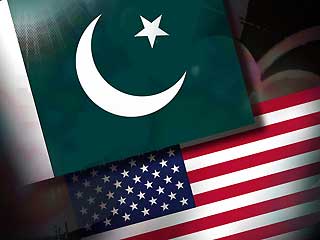Will MoU help bridge Pak-US trust deficit?
Brig (retd) Farooq Hameed Khan

While government circles hailed the MoU signing as a turning point in Pak-US ties, some politicians termed it as a document of ‘surrender’ or even Pakistan’s ‘death warrant’. Or was the MoU more of ‘Must Obey US’ set of conditions rather than an ‘understanding’ between two sovereign nations?
Few questions arise. Is the MoU tilted in US’ favour? Does this document safeguard Pakistan’s security interests? Did the US exploit Pakistan’s grave financial crisis to force a favourable deal on its terms and conditions? Was the draft document vetted/approved by the Parliamentary committee on national security?
Pakistan’s Ministry of Defence has the responsibility to act as a Central Coordination Authority to regulate and monitor the implementation of the supply route to Afghanistan. Pakistan is also required to ensure facilities for the security and quick transfer of the cargo and keep US government informed about the monitoring and transit points of the cargo.
When the US Charge D’ Affaires, Richard Hoagland announced the release of the long withheld 1.18 billion US dollars of Coalition Support Fund(CSF) just after the MoU signing ceremony, he sounded as if it was a great favour or reward to Pakistan for reopening the Nato supply routes. If US held back our legitimate CSF dues to arm twist Pakistan, what is the guarantee that such a blackmailing act will not be repeated any time its interests are threatened in future? Smart loopholes in the MoU may indirectly facilitate smooth weapons/equipment support to US/Nato forces. Although MoU disallows shipment of lethal military equipment for US/Nato in Afghanistan, such a restriction does not apply to equipment destined for Afghan National Army (ANA). Will some of lethal hardware under cover of ANA not end up with US/NATO as ultimate user?
While the parliamentary resolution called for a ban on transportation of lethal military supplies from Pakistan’s territory including airspace, the MoU is silent over the issue of use of our air corridors for this purpose. Does this not imply a blanket cover for US transport aircraft to carry weapons/ammunition across Pakistan’s skies? It thus makes an ideal combination – non-lethal equipment via Pakistan’s Ground Lines of Communication (GLOC) and lethal supplies through its Air LOC.
The US/Nato plan to train and equip around 250,000 strong ANA that would take over Afghanistan’s security after 2014. How would Pakistan’s concerns be satisfied that weapons destined under cover of ANA are not diverted to fuel Baloch insurgency, the Tehreek-e-Taliban (TTP) militants in Fata or Maulvi Fazlullah led TTP fighters based in Afghanistan’s Kunar/Nuristan provinces? The new agreement, reportedly applies to US/Nato supplies that have yet to arrive at Port Qasim. Thus thousands of US/Nato containers/trailers that were loaded with heavy military stuff and remained stranded in and around Karachi/Port Qasim since November 26 last, stand released to move towards Afghanistan.
Is it therefore not ironical that as in past, US/Nato’s logistic shipments through Pakistan will continue to fuel US drones that kill or maim Pakistani tribals in Fata? While we large heartedly allow weapons to equip Afghan security forces, the evidence of ANA involvement in cross border attacks on Pakistan Army cannot be ignored. Can the US/Indian Army trained ANA be trusted that it would not direct the same guns against Pakistan in case of any conflict on the western borders?
It was expected that the MoU would address the critical issue of US financial compensation for repair/rehabilitation of the damaged road infrastructure, which unfortunately is silent about the same. Pakistanis would have been satisfied had our negotiators clinched a quid pro quo in form of reasonable transit fees as per international trade practices on the lines that the US struck deals with central Asian states of northern distribution network.
Around 100,000 US/Nato containers are estimated to move out of Afghanistan in next two years. Since Pakistan Railways would also most likely bear the burden of transporting heavy US/Nato equipment to Karachi, then US must agree to a financial package for supporting our rail infrastructure if it desires a smooth withdrawal.
Will the arrival of newly nominated US Ambassador Richard Olson spell more trouble for Pakistan? His statement during US Senate confirmation hearing that squeezing Haqqani network in coordination with Islamabad is his top most priority may not be prudent approach while embarking on the new assignment and putting back on track a derailed relationship. The contradictions in US approach in dealing with Haqqanis are clearly visible. While it engages the Haqqanis secretly for a peace deal but wants Pakistan Army to attack the network’s so called sanctuaries in North Waziristan. It wants Pakistan to bring Haqqanis on negotiation table, but dangles the sword of declaring the network a terrorist organization.
After spending 90 billion US dollars in eleven years occupation of Afghanistan, if US/Nato have not secured Kabul, then why blame Pakistan for their own military failures? That the trainers failed to build trust with those they trained is evident from killings of over two dozen US troops by Afghan Army and police in 2012 alone.
Should a breakthrough in Pak-US relations be expected after DG ISI’s visit to Washington? Unless US addresses Pakistan’s security concerns related to drone attacks, US interference in Balochistan, support to Baloch insurgents/TTP militants from Afghanistan based training camps/sanctuaries, cross border attacks as well as guarantees of not repeating Abbottabad and Salala, there is little hope of early return to business as usual.
Will the MoU help to bridge Pak-US trust deficit? It led to restoration of NATO supply routes that ended the post Salala standoff. The MoU was also a first step towards much needed transparency in Pak-US relations. But mutual trust and respect still remain dream goals in a highly strained and fractious relationship.
The question that however baffles all Pakistanis is: When there is never a free lunch for Pakistan, why should we provide all meals free for US till 2015 and even later?





